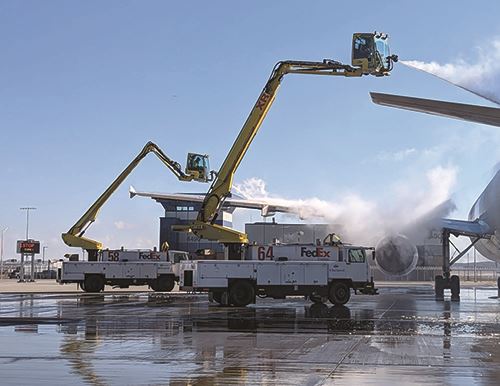Christmas came a little early at Memphis International (MEM) in Tennessee. The nation’s busiest cargo handling airport opened a centralized deicing facility (CDF) on Nov. 15, 2022, just in time for the busy holiday shipping and travel season.
Christmas came a little early at Memphis International (MEM) in Tennessee. The nation’s busiest cargo handling airport opened a centralized deicing facility (CDF) on Nov. 15, 2022, just in time for the busy holiday shipping and travel season. The new facility— the largest and among the most advanced in the world—allows cargo and passenger aircraft to deice just before takeoff, thus enhancing safety and efficiency.
 A total of 12 deicing bays serve large and small aircraft alike, supporting a wide variety of traffic—including approximately 265 daily outbound flights by FedEx, the airport’s largest tenant. Eleven of the bays are configured for aircraft as large as the Boeing 777F, and one bay is sized to accommodate a single Airbus A380/Boeing 747-8 or two Airbus A321/Boeing 737s at the same time. The facility also includes state-of-the-art guidance technology and an innovative 2.5-million-gallon glycol drainage and containment system.
A total of 12 deicing bays serve large and small aircraft alike, supporting a wide variety of traffic—including approximately 265 daily outbound flights by FedEx, the airport’s largest tenant. Eleven of the bays are configured for aircraft as large as the Boeing 777F, and one bay is sized to accommodate a single Airbus A380/Boeing 747-8 or two Airbus A321/Boeing 737s at the same time. The facility also includes state-of-the-art guidance technology and an innovative 2.5-million-gallon glycol drainage and containment system.
But it didn’t start out that way when planning began in 2014.
|
facts&figures Project: Centralized Deicing Facility Location: Memphis (TN) Int’l Airport Size: 3.3 million sq. ft.; 12 deicing bays Pavement: 3,300,000 sq. ft. of PCC Pavement; Deicing Pads: 3,000,000 sq. ft. of 17” PCC and taxiways: 300,000 sq. ft. of 18.5” PCC Total Cost: $309 million Funding: $174 million from FAA; $135 million from Memphis-Shelby County Airport Authority (MSCAA)
Glycol Management Study:
Project Design Through Construction: Facility Management: MSCAA Prime Designer & Lead Civil Engineer, Bridge Design: Kimley-Horn (Phases 1 & 2) Architect & Lead Designer: Ross Witt Architecture (Phase 3) Contractor: Chris-Hill Construction Co. LLC (Phase 1) Contractor: Joint Venture of RC Construction Co. Inc & EUTAW Construction (Phase 2) Contractor: Turner Construction Company (Phase 3) Surface Deicing Guidance System: JCAII Inc. Glycol Storage & Runoff Containment: Contech Engineered Solutions LLC
Electrical & Marking Design: Deicing Material Storage & Pumping: Burns & McDonnell
Cost Estimating & Scheduling:
Deicing Collection Planning Studies (Storage Volume): Blending Cubes: Liquid Automation Systems Geotechnical: K.S. Ware Building Architecture: Ross Witt Survey: THY Inc
Mechanical & Plumbing:
Vehicle Bridge:
Civil Design Support: Pavement Design: RDM Int’l Building Structural: Scallion Structural Engineering Lighting: TKH Airport Solutions |
Terry Blue, executive vice president of Operations/chief operating officer at MEM, explains that the final design was primarily driven by environmental requirements for dealing with glycol runoff and stormwater. In addition, the original vision was for a much larger facility because, at that time, MEM was still a dual hub for Northwest Airlines and Delta Air Lines, as well as FedEx.
“The original drawings called for something like 20 deice bays,” Blue recalls. “It was a massive, massive facility.” Airline de-hubbing, however, prompted MEM to reevaluate its deicing needs accordingly. The airport and Memphis-Shelby County Airport Authority (MSCAA) worked through the design with stakeholders—in particular, FedEx—through 2016 and 2017 to determine what elements were “must-haves” and what were “nice-to-haves.” The design evolved from traditional concrete deicing pads with painted markings, trench drains and a passive glycol collection system into a smaller, but far more sophisticated, facility. The final design also incorporated two South Field crossing taxiways with bridges over a landside road to provide landside access.
”That certainly increased the cost,” Blue acknowledges. “But in my mind, it was the right move, because of what it allowed for in terms of land use at that end of the airport.”
When MSCAA originally put the project out to bid, the cost estimates it received back caused a bit of sticker shock. That prompted the Authority to regroup with stakeholders, and together they determined that the full project scope was still the correct strategy. The Authority put the project back out to bid, willing to pay a bit more to get what everyone wanted.
Then the pandemic hit. The project was approved and funded, but the team once again needed to reevaluate the situation. With the full support of stakeholders, MSCAA Chief Executive Officer Scott Brockman decided to move forward with the CDF project.
“This is an environmentally driven project,” Blue says, “and it improves safety and operational efficiency at the airport at the same time. It needed to happen. So, we proceeded and got three great contractors on board that have done outstanding work. They managed to push through the pandemic and its supply chain challenges and have managed to deliver one heck of a project that we are ever so proud of.”
That $309 million project was funded with $174 million from the FAA and $135 million from MSCAA. Construction, which began in 2017, was divided into three main phases, allowing the facility to be built on an active airfield with minimal disruptions to operations.
Phase One was an enabling package that installed required infrastructure, including a depressed interior vehicle roadway (Louis Carruthers Road) that runs under two taxiway bridges and a vehicle bridge. The first phase also realigned landside access to some centrally located facilities on the airfield.
Phase Two provided most of the airfield components, including tank farms and deicing aprons. Two new cross-field taxiways were added to connect the south airfield’s west and center runways and provide access to landside traffic from Shelby Drive for glycol delivery and truck maintenance.
Phase Three added a tower that is fondly called the “Ice House,” which serves as the main hub for the deicing bays. It houses the electronics control facilities and truck maintenance bays as well as restrooms, break rooms and utility rooms.

Year-Round Benefits
Project designers focused on three primary goals: boosting efficiency, enhancing safety and reducing the environmental impact of deicing operations.
Innovative glycol drainage and collection capabilities provided by Contech Engineered Solutions were added to ensure environmentally conscious and compliant deicing. Original plans included a more traditional concrete vault glycol containment system. But when the project team went back to the drawing board, primary design engineer Kimley-Horn and Associates ultimately selected a steel-reinforced polyethylene system from Contech.
The segregated deicing drainage system includes:
- a 2.5-million-gallon DuroMaxx® underground containment vault for deicing runoff,
- a Type I and IV glycol distribution system with a capacity of 575,000 gallons,
- blending cubes for more efficient glycol usage,
- a centralized tank farm and pump house,
- aboveground and underground piping system and
- 1.5 miles of trench drains.
Justin Walton, area pipe manager for Contech, notes that the DuroMaxx system costs less than a traditional concrete vault and is relatively lightweight, which means installation was quicker and didn’t require cranes or other special construction equipment.
 From an operational standpoint, the system keeps glycol out of storm drain pipes and away from MEM’s downstream neighbors. Fluid release is metered into the sanitary sewer system, where it breaks down and helps sanitize the city’s wastewater.
From an operational standpoint, the system keeps glycol out of storm drain pipes and away from MEM’s downstream neighbors. Fluid release is metered into the sanitary sewer system, where it breaks down and helps sanitize the city’s wastewater.
The airport’s new system is fed by two inlets that carry collected fluid into a 60-inch diameter outlet, which flows into the pump house. For inspection and maintenance, there are 36-inch diameter vertical access risers. Airport maintenance personnel can remove the manhole cover and access the system to determine if it needs to be cleaned or flushed.
Contech supplied two diameters of pipe (120-inch and 84-inch), and nested the smaller inside the larger for transport to reduce the number of trucks delivering materials to the jobsite. The 120-inch diameter pipe was supplied in 40-foot-long pieces, and 84-inch pipe in 48-foot-long pieces, to minimize the number of joints for the system. Joints were internally welded with an HDPE extrusion weld technique, and the large diameter pipe was backfilled using rushed up concrete removed from another part of the airport. Walton notes that both of those strategies helped save money.
 The pavement for MEM’s new deicing facility required about 350,000 square yards of Portland cement concrete and 150,000 square yards of asphalt. The large, impermeable surfaces increase stormwater runoff throughout the year, not just during deicing season. As such, Kimley-Horn worked with the city’s stormwater group and civil engineering department to manage the additional runoff to stormwater systems, and eventually streams and rivers. The design team created a clever system that uses the new glycol detention vault for stormwater detention in seasons that aren’t impacted by deicing product runoff. “When it rains in the summer is when you’ll see maximal stormwater runoff,” explains Nathan Lemon, P.E., a civil engineer with Kimley-Horn. “So, we ended up dual-purposing this vault and using it to control that stormwater outflow from the site.”
The pavement for MEM’s new deicing facility required about 350,000 square yards of Portland cement concrete and 150,000 square yards of asphalt. The large, impermeable surfaces increase stormwater runoff throughout the year, not just during deicing season. As such, Kimley-Horn worked with the city’s stormwater group and civil engineering department to manage the additional runoff to stormwater systems, and eventually streams and rivers. The design team created a clever system that uses the new glycol detention vault for stormwater detention in seasons that aren’t impacted by deicing product runoff. “When it rains in the summer is when you’ll see maximal stormwater runoff,” explains Nathan Lemon, P.E., a civil engineer with Kimley-Horn. “So, we ended up dual-purposing this vault and using it to control that stormwater outflow from the site.”

Deicing Reimagined
In terms of efficiency, both the location and design of the new CDF will help streamline air carrier and cargo operations and reduce the frequency of associated cancellations and delays. Locating the new facility on the south end of the airfield, closer to where aircraft take off on MEM’s three north-south runways, reduces the need for repeated deicing. “The FedEx Hub and all the commercial airlines are toward the northern side of the airfield,” explains David Sparkes, P.E., senior aviation project manager at Kimley-Horn. “A lot of times, they were deicing aircraft at the ramps or other locations and, by the time they taxied all the way down to the south end to take off, they were collecting ice again.”
 Sparkes adds that centralizing deicing operations inherently promotes efficiency. “Taxi time and holdover time are elements of cost for airlines,” he explains. “There are a lot of benefits to having a centralized facility on an airfield—including promoting the flow-through of traffic and the ability to push aircraft at all times.”
Sparkes adds that centralizing deicing operations inherently promotes efficiency. “Taxi time and holdover time are elements of cost for airlines,” he explains. “There are a lot of benefits to having a centralized facility on an airfield—including promoting the flow-through of traffic and the ability to push aircraft at all times.”
Richard Kelsey, deicing program manager for FedEx, notes that having a uniform size and layout for the bays also provides a major advantage. Because MEM doesn’t typically get the snow and other winter conditions that airports further north deal with, ground crews and pilots don’t get as much experience with deicing operations. When aircraft were deiced in multiple areas on the tarmac, every pad was a little different, and the process was naturally less efficient. “Anytime you have to do a task over and over, such as deice aircraft, the more everything’s the same, the faster and more efficient you get,” Kelsey explains. “As we get acclimated to this new CDF over the next couple of deice seasons, the process will continue to get even faster.”
Each bay in MEM’s new facility includes a 45-foot vehicle safety zone, affording a much wider margin than the FAA-required 10 feet. This also allows crews to stage deicing vehicles facing aircraft, which helps the bays operate at maximum capacity because deicing trucks can evacuate the bays more quickly to allow the next aircraft to enter.

The location of glycol load stations and installing blending cubes directly on the pads allows deicing trucks to reload without crossing back and forth over active taxi lanes, thus saving time and enhancing safety. Without this design, airport personnel estimate that deicing crews would need to cross active taxi lanes about 144 times every three hours to keep their trucks properly filled.
The Brains of the Operation
Early in the planning stages, the Airport Authority directed Kimley-Horn to leverage external expertise regarding deicing technology. Based on the established list of “must haves” and “nice-to-haves,” the project team selected the SmartPad® surface guidance/operational control traffic management system and ICELINK, a web-based deicing process management system—both provided by JCAII Inc. The company’s innovative technological infrastructure are patented systems using infrared cameras, in-pavement lighting and electronic message boards powered by machine learning and artificial intelligence to guide pilots to and from their respective queuing locations.
Ironically, the high-tech system is actually a lot like an automated car wash. Built on automated safety systems, SmartPad’s lights and signage tell pilots where to enter, park and exit the CDF. However, the system is also programmed with specific deicing protocols based on aircraft type, route, weather conditions and historical data tied to proprietary algorithms.
Pilots can use ICELINK to interact with deicing personnel for more instruction and request accuracy and expediency. The web-based system also provides real-time operational data to the airlines, the airport, deicing service providers and other stakeholders for planning, training and auditing.
TKH Airport Solutions supplied the addressable lighting, which enables strobing and chasing effects for more dynamic control. The company’s CEDD airfield ground lighting technology integrates with the SmartPad system. The installation consists of more than 1,200 smart taxiway and stop bar lights installed on the east and west aprons of the deicing bay and 32 base stations that power and communicate with the fixtures. The unique CEDD technology doesn’t require transformers or connectors, making it far more resistant to water and deicing fluids than traditional airfield ground lighting technology.
Together with the electronic message boards that display directions, relevant process information and holdover times, the lights provide clear visual commands that guide aircraft into place for deicing.
These technology components minimize verbal communication with pilots, reduce ground vehicle traffic and eliminate the need for flagging personnel to position airplanes in the bays. The automation allows MEM to dedicate more personnel to the actual deicing operations.
 Jeff Campbell, president of JCAII, notes that in addition to directing aircraft, the SmartPad and ICELINK systems provide MEM with a single point of control and analysis, providing instantaneous data to inform real-time decision-making and provide insight for planning purposes. SmartPad’s surveillance and metering features provide real-time graphic representation of activity at the deicing facility, which maximizes safety by keeping everyone on the same page.
Jeff Campbell, president of JCAII, notes that in addition to directing aircraft, the SmartPad and ICELINK systems provide MEM with a single point of control and analysis, providing instantaneous data to inform real-time decision-making and provide insight for planning purposes. SmartPad’s surveillance and metering features provide real-time graphic representation of activity at the deicing facility, which maximizes safety by keeping everyone on the same page.
Campbell refers to the two systems as “the standard operating platform for the modern airport and airline winter operations.” The information they provide allows FedEx and other carriers to view their operations at MEM remotely. Airline personnel can see how MEM deicing activity compares to their other ICELINK-equipped locations to assess overall performance. At audit time, regulators can access clear, consistent and standardized information, which drives best practices and automates compliance.
Personnel in the 1,600-square-foot deicing control tower manage aircraft ground traffic to and from the CDF. The tower, which is located between the two sets of deicing bays, includes space for tenant personnel to manage deicing operations during large-scale operations. The adjoining area provides approximately 25,000 square feet of leased space for tenant vehicle maintenance and deice operations.
Layers of Expertise
From the airport’s perspective, Blue credits much of the project’s success to early and frequent collaboration. In particular, he says that directing Kimley-Horn to loop in a company with a lot of practical deicing experience from the very beginning ended up being a key move. “[JCAII was} able to bring knowledge and experience about deicing operations around the world, which was very helpful to the design team and to the Airport Authority,” he reflects. “It was really important to have that operational experience incorporated into the design.”
In turn, JCAII was happy to offer the knowledge it has learned while providing systems that facilitate deicing at nearly 300 operations across the globe.
“For many years, my team and I have traveled to see most of the existing deicing operations around the world,” Campbell says. “It’s through the development of our SmartPad and ICELINK technology in the context of digitalizing winter deicing operations that we were able to condense and apply best practices and layouts of our fieldwork to create and develop a standardized process and traffic management platform.”

Lemon and other Kimley-Horn personnel highly value the extensive resources and expertise the project team had access to. “There were a slew of challenges, but nothing that we weren’t able to overcome as a group,” Lemon says. “At the end of the day, we needed all that expertise to complete this very large, complex facility.”
 FedEx also was thrilled to help plan the new CDF. “This was MSCAA’s project, and they did all the coordination,” says Kelsey. “But any better partner than MSCAA wouldn’t be possible. We’re so thankful that FedEx was included from the get-go. We tend to want to ‘FedEx-ize’ pretty much everything that we’re involved in. They were very good at listening to our needs and wants and involving us.”
FedEx also was thrilled to help plan the new CDF. “This was MSCAA’s project, and they did all the coordination,” says Kelsey. “But any better partner than MSCAA wouldn’t be possible. We’re so thankful that FedEx was included from the get-go. We tend to want to ‘FedEx-ize’ pretty much everything that we’re involved in. They were very good at listening to our needs and wants and involving us.”
Blue agrees that the project benefited from this close partnership. “From day one all the way through to the very end, we had a lot of collaboration,” he says. “What’s really remarkable is that collaboration hasn’t stopped since we cut the ribbon—and quite frankly, I don’t ever expect it to stop. As we were approaching the finish line, our two teams were talking on a daily basis almost as if they were all part of the same organization.”
Model for the Future
That exceptional level of collaboration is something high on the list of recommendations for other airports considering or planning CDF projects. “I think the one thing we absolutely did right is that we had key stakeholder engagement all the way through,” Blue remarks.
In fact, if the project team had decided to simply follow FAA guidance, MEM’s new facility would be drastically different. “And it would not have nearly the level of safety or efficiency designed into it that it does,” he notes.
Campbell adds that the entire CDF—from the remote deicing pad layouts to the operational process standards—represents the most advanced deicing system platform in the world. “The application of the technology coupled with the collaboration with Kimley-Horn and the Memphis Airport and their desire to be the best in the world has delivered a truly world-class system that the users will benefit from for many decades to come,” he says.
The new facility was already put to the test when a winter storm hit Memphis on Dec. 22—at the height of FedEx’s holiday push. Because the bad weather rolled in around 5 p.m., the cargo carrier only had to deice 19 aircraft that evening. And the new CDF worked just as it was designed to. “The feedback we got is that things ran very smoothly,” Kelsey reports. “The pilots are very confident and comfortable coming into the facility and using the ICELINK technology.”
It’s working so well, in fact, that Kelsey thinks the layout and design should be a model for the future, especially given the environmental advantages of its glycol collection system. To that end, he’s already given many in the aviation industry a glimpse of what’s possible.
“You wouldn’t believe the number of tours I’ve already given,” he says, noting that even UPS has come to check out the new facility. “Sure, we’re competitors, but when it comes to these types of things, we’re all in it together.”



